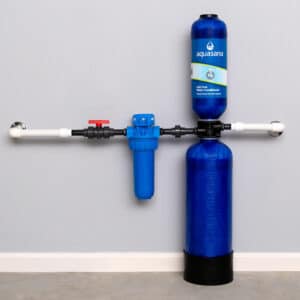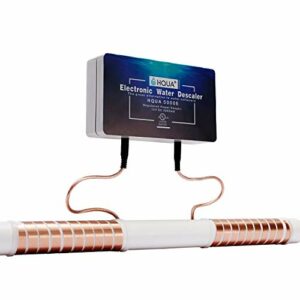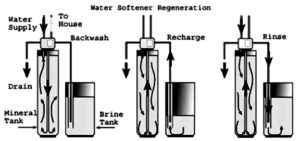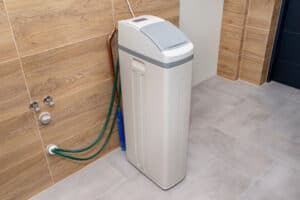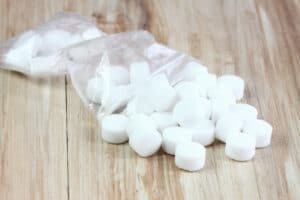A water softener salt bridge is a common problem you’ll encounter when using a water softener. Salt bridges reduce the effectiveness of your softener by limiting the amount of salt used in generating the brine solution used in regeneration cycles.
From the top, a salt bridge looks like regular softener salt, but there could be a gap between the bridge and the water in the brine tank. But how does a salt bridge occur, and what should you do about it?
What Is a Water Softener Salt Bridge?
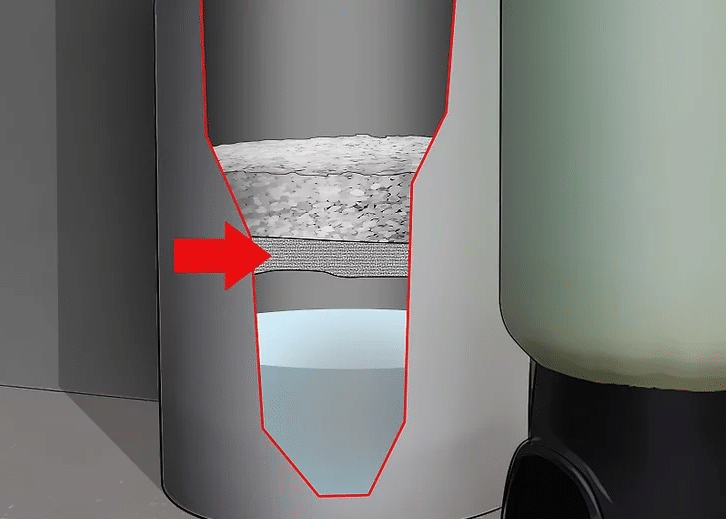
A water softener salt bridge is a hardened layer of salt that forms a barrier inside the brine tank. The salt bridge is firm to the touch and holds its place when you press down on it.
To understand how it develops, you must understand how a brine tank works. The brine tank serves as a salt storage. During regeneration, a controlled amount of water enters the brine tank and dissolves the salt to form a concentrated solution. This solution gets used to restore the positive ions in the resin tank for effective water softening.
Brine tanks must have more salt than water to create an effective regeneration solution.
Due to the low amount of water required in brine tanks, the excess salt may clump together and form a hard layer. This layer prevents any salt you add from reaching the water below. This layer also prevents water in the brine tank from dissolving any salt.
With time, the brine tank depletes any salt below the salt bridge. Once it’s depleted, the regeneration process becomes less effective.
The first sign of a salt bridge is hard water in your home, despite the softener running through regular cycles. The brine tank might have sufficient salt for each regeneration cycle, but you still get hard water.
Another sign you could be dealing with a salt bridge is that you are using less salt than usual despite using the same amount of water.
Causes of a Water Softener Salt Bridge
Water softener salt bridges occur when salt particles clump together to form a hard crust inside the brine tank. It can happen for several reasons:
Using the Wrong Type of Salt
Poor-quality softening salt can cause bridging. Such salt lacks additional ingredients that prevent caking. It also has impurities that cause further problems like clogging. When choosing the best type of salt for your softener, follow the manufacturer’s recommendation.
The size of the salt crystals you use also influences the occurrence of salt bridges. Small salt particles are more likely to cause salt bridges, as they have a smooth surface area that allows better bonding.
Too Much Salt
It’s tempting to leave a large amount of salt in your brine tank to reduce the number of trips you make. However, leaving too much salt in the brine tank results in bridge formation. The excess salt forms a hard crust, affecting the water-softening process. Too much salt can also lead to more severe problems like salt mushing.
High Humidity in the Brine Tank
High humidity in or around the brine tank moistens the salt in the brine tank, causing it to crystallize and solidify. When the salt in contact with the water dissolves and recrystallizes, a hard salt layer is left behind, forming a salt bridge.
Humidity in or around your brine tank could occur due to the following:
- Leaving too much time between regeneration cycles
- Overfilling the salt tank
- Placing the water softening system in a high-moisture environment
Salt bridges that form due to high humidity are normal during the summer. Therefore, check the brine tank more regularly to remove any deposits.
Water Leaks
Water leaks in the water softener, connection pipes, or water tanks could leak into the brine tank, introducing enough moisture to wet the salt but not dissolve it. The salt eventually hardens and forms a salt bridge.
Not Cleaning the Brine Tank Enough
Failing to clean a brine tank can result in a salt bridge. In this case, the salt bridge may form slowly over time, explaining why you may fail to notice it. You should remove any small buildup on the sides of the brine tank as soon as they occur to prevent a salt bridge from forming.
Low Levels of Water in the Brine Tank
Wet brine tanks always have some water in them, even after the regeneration cycle. When this water gets too low, it can lead to the formation of a salt bridge. The salt bridge forms when the salt in contact with the water becomes moist and hardens. The water could also evaporate, increasing the moisture content in the brine tank and causing a salt bridge to form.
Removing a Water Softener Salt Bridge
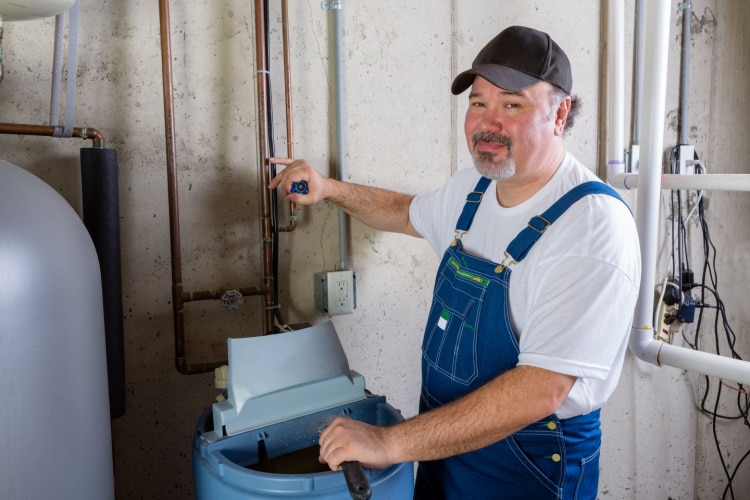
If you’ve confirmed that you have a salt bridge in your softener, the next step is to remove it. The removal process is simple, but you must be careful not to damage the softener.
Here are the steps to remove a water softener salt bridge from your brine tank:
- Turn off the water supply to the water softener.
- Drain the brine tank using a garden hose to remove any water and salt in the tank.
- Scoop out any loose salt above the salt bridge.
- Get a long
,robust tool that you can use to break up the salt bridge. It could be a mop or broom handle. Avoid using sharp or pointed objects as they can pierce the plastic walls of the brine tank. - Use the broom handle to chip away at the salt crust. Use gentle but firm stirring motions to ensure you don’t hit the brine tank. If the broom handle cannot remove these chunks, pour warm water in circular motions over the salt bridge to soften it.
- Scoop out the salt chunks.
- Once you’ve dislodged the salt bridge and removed the salt chunks, use a wet or dry vacuum to remove the water from the bottom of the tank.
- Use warm water to clean the brine tank and dissolve any salt left in the tank.
- Add fresh salt to the brine tank, ensuring it’s between ¼ to ½ full.
- Set a new regeneration and check whether your house is receiving soft water. Repeat the regeneration process a second time and check whether all the salt is used up.
- If the salt from earlier has gotten used up, refill the tank up to halfway with high-purity salt and let your water softener operate as usual.
You might be dealing with another water softener problem if you still receive hard water after removing a salt bridge.
How To Prevent a Water Softener Salt Bridge
Although salt bridges can be an inconvenience, you can prevent them from forming using the following tips:
- Do not overfill your brine tank. It’s recommended to fill ¼ to ½ of the tank, but never exceed 2/3 full. Instead, fill up your tank with less salt regularly. This works well if you live in a high-humidity area.
- Level the salt properly when you add it to the brine tank.
- Use the right quality and type of salt. Manufacturers often recommend the best salt to use with your softener. Softener salt with the highest purity levels is the best as it leaves less residue in the brine tank.
- Clean your brine tank at least once every month. During the cleaning, check the tank for any deposits around it. Inspect the tank for cracks, chips, or other signs of damage contributing to salt bridge formation.
- Keep the lid of the brine tank tightly closed to prevent warm moist air from entering the brine tank, especially during humid weather. If your water softening unit is outside, use a covering to prevent water from leaking into the brine tank.
- Seal any water leaks in the connections or valves to the tanks.
Final Thoughts
A water softener salt bridge develops when salt in the brine tank crystalizes into a hard crust, preventing any salt you add from reaching the water in the brine tank. When this happens, your water softener becomes ineffective at delivering soft water to your home. Luckily you can remove the salt bridge and prevent it from happening.

